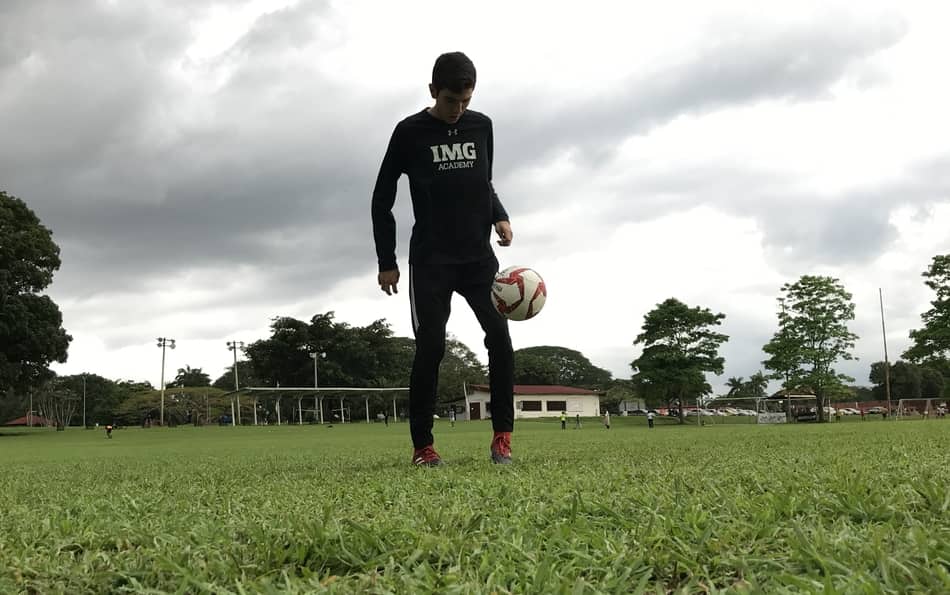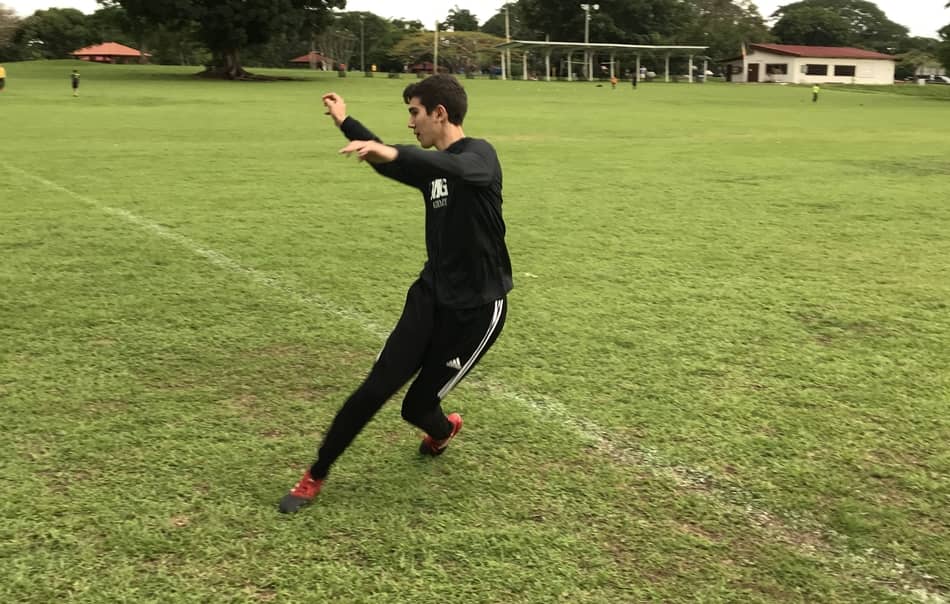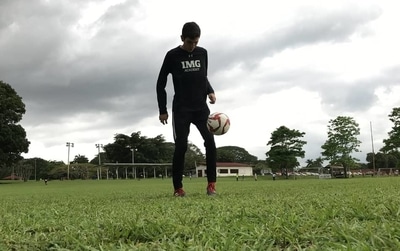
Every day I ask the question to myself: How can I become a better soccer player and be closer to becoming a professional? It is then when it came to my mind the following thought: How am I supposed to be the best player out there if I keep doing the same things that my teammates, and everyone else is doing?
I mean, going to soccer training on time and training hard every single day at practice will definitely make you a better player, but maybe not the best, and that is what we are aiming for, right? Think of it in this way: How are you supposed to differentiate yourself from other players if you do exactly the same as they do.
Yes, maybe you think you train harder than them at soccer practice, but to be realistic, the only way you start taking a step forward is that you do more than you are asked for. Giving that extra push, extra effort is what will mark the difference in the future to the decide whether you take this to the next level or not.
In your attempt to achieve your goals in soccer, you’ll see yourself training alone, all by your own. Training by yourself is not an easy task. Usually, at training, you have your coach to tell you what to do and guide you through everything. Now you are all alone, by yourself, and you’ve got to be your own coach, which is a big challenge.
Find your why
One of the most important factors that will determine your success, not only in soccer, but in life, is motivation. How bad do you want to be succesful? What are you willing to sacrifice to get to where you want to be? It is very important to establish a why even before you start training by yourself.
Something I do before I start aiming towards a new goal is that I ask myself why am I doing this. So ask yourself the question and take a notebook, your notes app in the phone, or anywhere you like to take notes and write the reasons why you want to start training by yourself.
Try to make elaborated answers. Do not write something simple like: “I want to become a pro”. There should be more reasons why you are doing it more than just wanting to become better. What do you get by becoming a better player? What do you get back if you become a pro? Question absolutely everything.
Once you wrote it down memorize all your reasons and keep them in your mind. At the beginning, you will be very motivated but as time goes on you will start losing motivation if you forgot your why. The power of remembering and believing in yourself when you wrote those whys is what will determine if training by yourself will be worth it or not.
But why am I talking to you about this? Why is this even important? When you train with teammates and coaches it is easier to keep motivated because you’ve got other people that are also pushing towards the same goal. When you are alone, and giving an extra mile, it is extremely hard to stay motivated.
Most people will stop training by their own after some time, but remember this:
“A river cuts through a rock not because of its power, but because its persistence”
– Jim Watkins.

Where? What do you need?
So the idea is that you can train by yourself with the least amount of equipment and facilities possible. Some of the following drills were made so you are able to do them anywhere: at your house’s backyard, at an empty lot, at school, or basically anywhere you have space to do exercise.
They were created to use as little resources as possible. The only things you are going to need for sure are a pair of cleats or sneakers and a soccer ball. Try to be creative. Avoid spending too much money in equipment that you don’t need. Try using the things you already have at home. Anything simple like a pair of shoes, water bottles, piece of clothing or any object you find around might be useful.
What will determine if you get better training by yourself is not the equipment you have, but the commitment and effort you put into it with the little you have.
If you plan on taking this to the next level, a portable soccer goal can help you out dramatically. It will open new possibilities to drills you can do, and can be a handy tool you can take anywhere to help you improve as fast as possible. In my recommended portable goals page, you’ll find portable goals from al prices and sizes.
Recommended drills
Obviously, always remember before every single training session to have a nice warm-up. There are two important reasons you should warm-up before every individual training session. The first one, obviously, is to prevent injuries. The second one is to mentally program your brain that your about to start a training session. It may sound dumb, but warming up before an individual session can help you stay focused to achieve your daily goals.
Wall drills
With something as simple as a wall, soccer players have endless possibilities of things they can do to improve their skills. You can train everything: shooting, passing, touch, and even ball control.
- So the first drill is the most simple one. Just pass the ball at a decent pace to the wall, wait for the bounce and keep passing the ball back over and over again. You can try different variations: one-touch passing or doing an oriented control and then passing it back. This exercise helps improve your passing technique, ball control, and first touch.
- The second one, is a drill I like doing to practice ball control. You are going to stand about 5-8 meters away from the wall, and you are going to kick the ball as hard as you can to the wall. The bounce will come at you very fast, so your challenge is to control the ball the best way possible without letting it bounce away from your feet.
- Juggling with the wall: You are going to pass the ball to the wall while keeping it in the air without letting it fall. I would try doing this exercise for 90 seconds straight without letting it fall to the ground.
You can make variations to each one of this exercises to make them harder or easier for you to do. Get creative with it. Add more touches or take away some. Use a shoe or a water bottle to mark an area where to make or receive a pass… I repeat, the opportunities with a wall are endless and can bring you great results.
Stamina and dribbling drills
What is best about stamina drills is that with most of them you won’t need basically nothing else than your body. What is even better is that almost any stamina drill can become a dribbling drill if you add a soccer ball to it. So that is exactly what the following 3 drills are all about.
- The clock: For this drill, you are going to need three objects of any kind. You are going to place them in front, to the back, to the right, and left from your position. You’ll notice as it was a clock and the objects are in the numbers 12, 3, 6, and 9 positions, and you are right in the middle of the clock. You are going to run forward to the object that is in front of you and then back to the middle, repeating the process with each cone, rotating clockwise with intensity. You’ll do this for 90 seconds as fast as you can. Run forward to the object in front, backwards to the one behind you, and sideways to the ones on the side. Be sure to touch each cone with your hand.
- This next one is very simple one, but one that is easily the exercise that has demanded more conditions for me to do. You are going to use two objects that are separated about 80 yards away from each other (about 3/4 of a soccer field), and you are going to run at 100% effort from one to another. Everytime you get to one object take a 45 seconds rest. Run 7 times between each cone. You can add a soccer ball to practice high-speed dribbling, but remember that you must run at a 100% effort.
- Classic Shuttle run: This is one of the most known drills in soccer, and you can do it with or without a soccer ball. So you are going to align 4 or 5 objects in a straight line, separated around 6 yards away from each other. You are going to run to the first cone, then back to where you started, then you run to the second mark and back again to the beginning, and so on until you get to the last cone. This is one of the best drills to improve your stamina and dribbling technique.

Shooting and passing drills
- Long distance passing: To practice this, the only thing you’ll need are two objects once again. Put both of them at a distance away from you of about 10-20 yards, and try passing the ball through the middle of both objects. You can practice doing it with a rolled pass or a low lob. If you have more than 1 soccer ball, you can try positioning them away from you and making a pass aiming to hit the other balls. In this way you practice the precision in your passes.
- This second exercise can be done either with a wall or a soccer goal. You are going to position backwards from the goal, you are going to throw the ball up and, with only two touches, you have to turn around and shoot to the goal or wall. With this drill you practice finishing and your first touch.
If you’d like more drills you can do by your own, check out this incredible youtube video I found with 100 drills you can do by your own. Totally recommendable, you’ll never run out of drills to do.
How to get the most out of this drills
There are two words that are key if you want to successfully improve as a soccer player training by yourself: Commitment and dedication. Without that you are going nowhere, no matter if you have 100 or 1000 drills. You need to be committed to get out there in a consistent routine to train by yourself.
This is not like school or soccer practice where the coach tells you to run or do the drill correctly. This is something you chose to do by your own, and nobody will tell to do the things well if it’s not yourself. Every time you make every single drill you have to do it conscientiously. More than just saying it, you have to demonstrate to yourself how committed and dedicated you are to this cause.
Also, always remember that quality beats quantity every single time. I prefer doing 10 well-done drills than 25 drills done just for the sake of doing them. How you train will reflect how you play in the games so always put in the maximum intensity to it and train as if you were in a real game.
Work on your weaknesses
Normally, at training we want to play the best we can because you want to impress the coach and the teammates. So usually when we are training we try to avoid doing things we know we are not good at like shooting with our weak foot or heading the ball. It is when we are completely alone when we have the chance to improve our weaknesses and become more complete players.
For example, Lionel Messi is one of the best free kick takers today. But some years ago, he didn’t take a single free kick because he was not so good at it. Some people say Diego Maradona in the year 2006 gave him some tips on how to take better free kicks. Since then, Messi started practicing free kicks by himself after training and transformed one of his weaknesses in one of his best strengths.
Giving the extra mile
Complete players are not the ones that spend countless hours training in the soccer field, but also the ones that know how to become better players outside of it. Your labor to improve has to continue even when you finish training on the field. Giving that extra mile, and doing things that are different from what everyone else is doing is something that will set you apart from the crowd.
Working on nutrition
We are what we eat they say, and oh man it is so true! You see, it doesn’t matter if you have the best and most complete workouts, if you don’t have a proper nutrition then it is worthless. There is so much information out there about how to have a proper nutrition as an athlete, and best of all, it’s free. Just start deeping inside this nutrition world and you’ll start seeing better results in your body.
Mental Conditioning
There are 4 areas every athlete has to train if they want to become elite one day. They are: physical, technical, tactical, and mental. The mental part of the game is maybe as important as the physical part, specially in a game like soccer. It is important that you exercise areas of the mental part like: composure, confidence, and mental toughness to become a more complete player overall.
How to know you are overtraining?
Probably you’ve asked the question: so how do I know when I am overtraining? You have to be very careful with this. It is always good to put more work in than what is normal, but you always have to know what your limit is. If you get to the point that you overtrain it would be more prejudicial than helpful. Always remember that getting good rest is as important as training hard.
Here are some things that may be a sign you are overtrainig:
- Soreness in your muscles for extended periods of time.
- Sleeping too many hours and problems to fall asleep in the first place.
- Changes of mood.
- Unexplained illness.
- No progress in muscle growth.
- Extreme fatigue.

